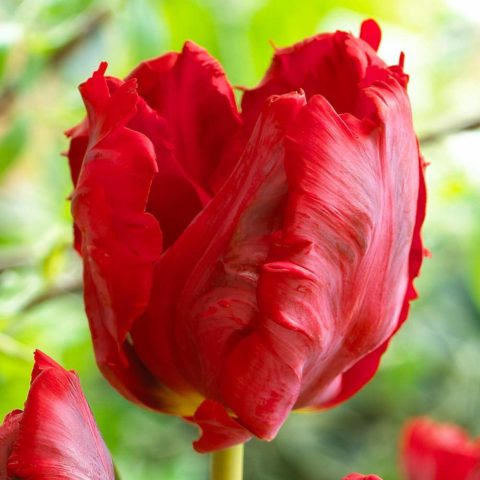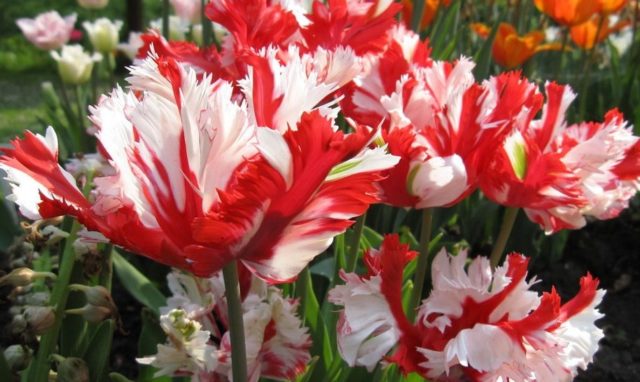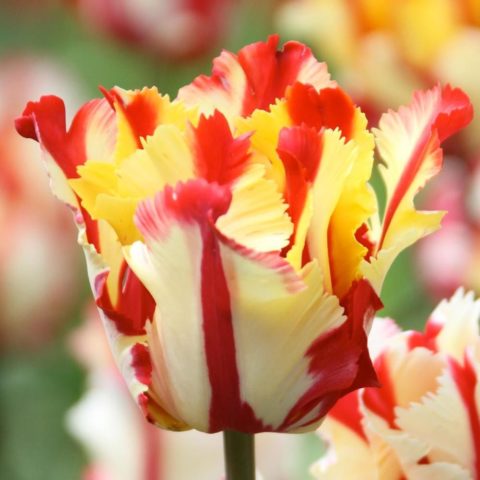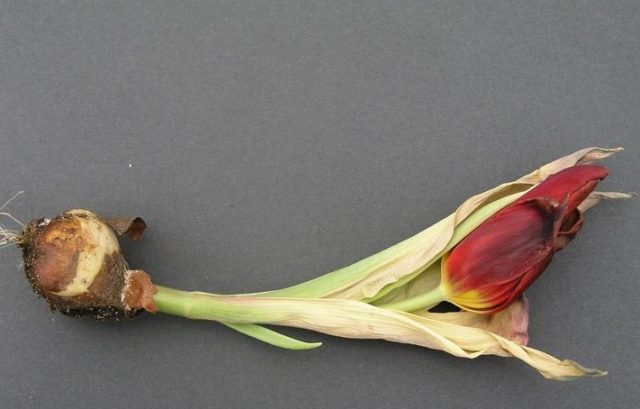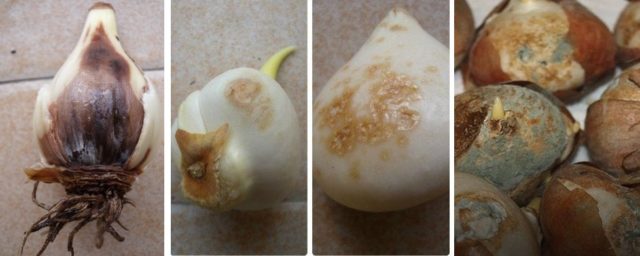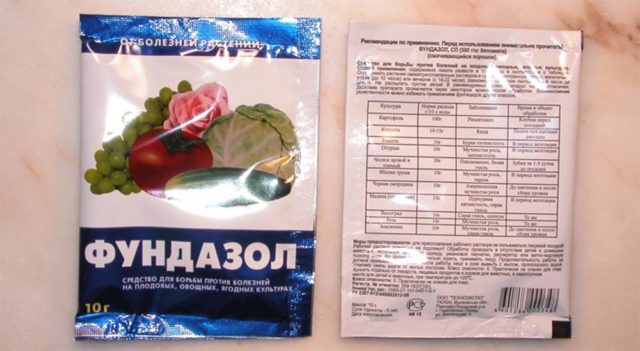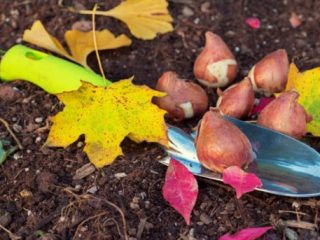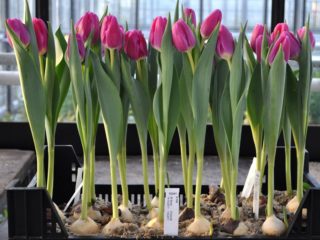Content
Parrot tulips in appearance resemble the plumage of exotic birds, hence the unusual name. The variegated colors and unusual shapes of these varieties delight the eye and allow you to create a bright island on the site. Parrot tulips arose due to gene mutations, their progenitors were late-flowering varieties.
Description of parrot tulips
Parrot tulip varieties are classified as highly decorative crops. They are distinguished by a long, thin stem and a large flower. The height of the shoot ranges from 35-55 cm, the bud reaches 12 cm in length and 20 cm in diameter (when the flower opens).
The best varieties of parrot tulips
The variety of parrot tulips allows you to choose a variety that meets the needs of any grower. The most popular varieties:
- Tulips Apricot Parrot have a pinkish-peach color of the buds. The stem height does not exceed 40 cm. Flowering time is April. This parrot variety is used not only for landscaping the site. Flowers are suitable for cutting.
- Black parrot refers to monochromatic parrot species. It has a noble purple color and delicate petals. Its stem is about 45 cm long. Flowers are used for cutting. The flowering period falls on the end of April - the first days of May.
- Parrot variety Red parrot the buds are painted in shades of carmine red. Its height ranges from 40-65 cm. Refers to late-flowering parrot species.
- Of the two-color varieties, in demand Estella reijnveld (Estella Rizhnveld). Small buds (up to 7 cm in length) are full of crimson-red and creamy-white stains. The culture blooms in May. They use the parrot variety in landscape design, as well as for cutting. Tulips grow in well-lit flower beds, but partial shade is also suitable for them.
- Yellow-red bicolor parrot cultivar Texas Flame (Texas flame) reaches a height of 45 cm. Tulip flowers are cupped, strongly dissected, have a faint aroma. The flowering of the variety is long, medium late.
Planting and caring for parrot tulips
Ornamental crops require special attention. For planting parrot tulips, it is necessary to choose a suitable site and provide proper care.
Selection and preparation of the landing site
The land should be loose, fertile. For parrot varieties, the site should be open, with good lighting, but no drafts. The earth is pre-dug to the depth of the shovel, weeds are removed.
Landing rules
When planting, maintain a distance between the holes of at least 20 cm. The bulbs are buried in the ground by 10-15 cm, covered with soil and slightly crushed. The plot is watered and mulched with peat or straw.
Watering and feeding
Parrot tulips need regular watering. If it rains rarely, the soil is moistened at the rate of 20 liters per 1 m².
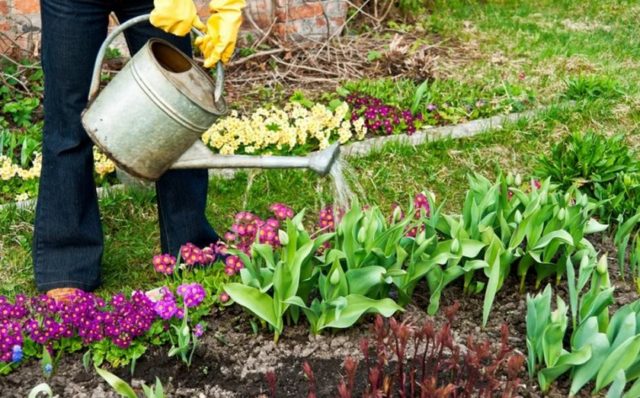
Watered at intervals of 2 times a week
After flowering, the ground is moistened for two weeks, then watering is stopped.
In the spring, after the appearance of foliage, the culture can be fed with any mineral fertilizer. After flowering, dried parts of the plants must be removed. The leaves are cut off only after their complete yellowing and dying off.
Reproduction of parrot tulips
Reproduction of tulips at home is carried out with the help of children. For this, a site with parrot varieties is carefully dug up, taking out the bulbs. The procedure is carried out after the foliage has dried (in August).
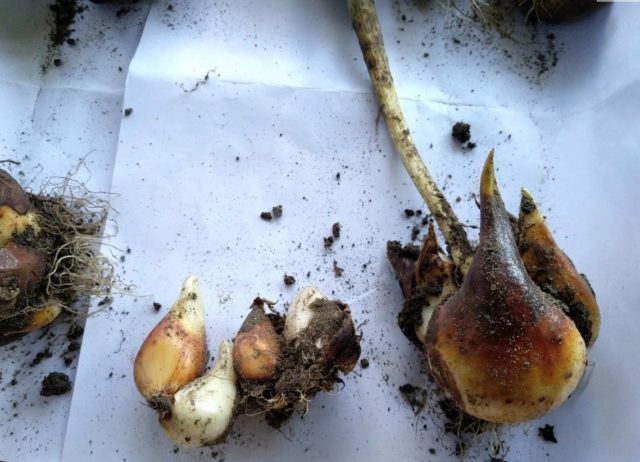
Daughter specimens are separated and inspected for rot and spotting.
Damaged bulbs are discarded, large and healthy ones are sent for storage in a dry and cool room.
Planting children of parrot tulips is carried out in the fall, but if the deadline is missed, the spring procedure is also allowed.
Seeds collected on their own are not used for planting, since it will not be possible to obtain an ornamental crop that corresponds to varietal characteristics.
Diseases and pests of parrot tulips
Viral and fungal diseases are dangerous for parrot tulips. Among them are:
- White rot. The causative agents are viruses. The disease is most often recorded in regions with acidic soil. Excessive watering or high humidity caused by precipitation can provoke the appearance of the virus. The disease can be detected in the spring, when part of the planting material does not germinate or gives small shoots that quickly turn yellow and die. After digging up damaged plants, you can see bluish-gray spots on the bulbs, while the roots will appear completely healthy. White rot can affect the neck and growth point. In this case, you can notice a whitish bloom, which soon begins to turn brown. The plant dies, and the spores of the fungus continue to live in the ground for 5 years.
- White striping. Occurs on acidic soils with excessive nitrogen content. It affects flowers and leaves of plants, causing dwarfism and the appearance of white stripes.
- Botrythia rot. Its appearance is provoked by the fungus Botrytis cinerea. The bulbs darken, acquiring a brown color and softness, black spots consisting of mushroom mycelium can be detected on them. Tulips sprout poorly or do not appear at all. The sprouts that appear are sluggish, weakened, they quickly break down and die. The appearance of the disease is facilitated by high humidity or late disembarkation.
- August disease (necrotic spot) often affects early flowering crops, but can also be found on parrot tulips. It is caused by the tobacco necrosis virus. Infection occurs when the bulbs are mechanically damaged. The disease can be suspected by longitudinal brown strokes, as well as by curved and drooping stems. When viewed from the bulb, you can see putrid brownish areas on it. Daughter bulbs and children are affected, the disease does not spread to neighboring plants.
- Fusarium. The causative agent is a fungus that activates at temperatures above 20 ° C and high humidity. A sign of infection is the coloring of the roots in a yellow-brown hue, as well as poor flowering and grinding of flowers.
- Gray rot. Its appearance is associated with fungi. The rainy and cool weather becomes a provoking factor. The disease can be identified by deformed buds and twisted stems. When examining the bulb, you can see gray-yellow spots of various sizes on it.
To prevent the development of diseases, the following recommendations must be followed:
- Inspect the dug out bulbs carefully. If stains, cuts and other flaws are detected, reject them. Recheck material for visible damage prior to planting.
- Storage should be carried out in cool rooms, where the air temperature is 15-19 ° C, and the humidity does not exceed 60%.
- 2 weeks before planting, the bulbs are treated with a solution of Fundazol, Benlat.
- Immediately before planting in the ground, the bulbs of parrot tulips are etched in formalin (1%) for 5-6 hours.
- For cultivation, you should choose sunny and well-ventilated areas.
- Thickening of the plantings should not be allowed, excess bulbs should be dug up and planted, keeping a distance of 20 cm between neighboring plants.
- If the soil is too acidic on the territory, liming is periodically carried out.
- If diseased bulbs are identified on the site, this area is not used for growing tulips for 5 years. If it is not possible to allocate another flower bed for parrot tulips, disinfect the soil with a formalin solution. For processing 1 m², 10 liters of 1.5% composition will be required. Then the soil is covered with a film or spunbond.
Of the pests, the danger is:
- Root mite, damaging the bulbs of parrot tulips. Warm weather (25 ° C) and high air humidity (more than 75%) contribute to the reproduction of the pest. Unfavorable conditions lead to the fact that the tick goes into a dormant stage, but at the same time does not lose its viability. To combat it, various methods are used: heat treatment of the bulbs, sprinkling with chalk, etching in Keltan's solution, spraying with Rogor.
- Greenhouse aphid damages foliage, shoots and peduncles of parrot tulips. It is also a carrier of viral diseases. To combat aphids, spraying with chemicals is used. As a preventive measure, planting around the perimeter of a flower bed of pyrethrum and other insecticidal crops is recommended.
- Onion hoverfly larvae bulbs of parrot tulips are struck. To combat them, use a solution of karbofos or heat treatment of planting material. Deep digging of soil on the site in the autumn is also effective.
- Purple scoop. To combat it, dusting the bottom of the parrot tulips with mothballs is used.
- Beetle larvae. You can get rid of them with the help of deep digging of the soil.
- Wireworm. To eliminate the wireworm that damages the bulbs of parrot tulips, it is enough to spread baits (pieces of potatoes, beets) around the perimeter of the site. The introduction of ammonium nitrate into the soil helps to reduce the number of larvae.
Photo of tulips parrot
The design of the territory sometimes causes difficulties for novice gardeners. Photos of parrot tulips in the landscape will help with ideas for creating unusual colorful flower beds.

Parrot tulips can grow not only in open areas, but also in special flowerpots.

Bright flowers can decorate the shore of any body of water

A circular planting looks unusual, where various tulips alternate
For parrot varieties, good neighbors will be:
- conifers, which will not only highlight the beauty of flowering plants, but will also protect them from the wind;
- streams, forget-me-nots will create an eye-pleasing contrast of wealth and modesty;
- crops with decorative foliage (spurge).
Parrot tulips can be planted in flower beds, in flower beds, in special containers, in open areas.
Conclusion
Parrot tulips are extraordinarily beautiful both in a flower bed and in a vase. They are grown to decorate the territory, as well as to create colorful bouquets. Propagated using bulbs on the site and in the greenhouse. With proper care, seedlings practically do not get sick.


